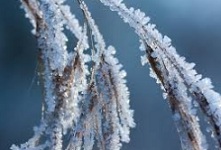 Frost occurs when night dew freezes due to low temperatures . This phenomenon takes place in many regions during winter, or even in other seasons when it is very cold .
Frost occurs when night dew freezes due to low temperatures . This phenomenon takes place in many regions during winter, or even in other seasons when it is very cold .
Dew arises when the vapor in the air, due to the coldness of the night, condenses and becomes drops that appear on different surfaces. The cold itself then causes those drops to transform into frost.
Frost, therefore, is a thin layer of ice that can form on plants, cars, etc. Also known as white frost , it is a phenomenon caused by condensation (vapor droplets become a solid), and not precipitation (water that falls from the atmosphere and reaches the surface).
For frost to appear, the surface temperature must be below 0 °C , while the relative humidity of the air must be greater than 60% . If these conditions are not met, there will be little vapor in the atmosphere and it will not deposit on surfaces, and it will not freeze.
Plants can suffer various problems due to this natural phenomenon. When frost covers the leaves, the plant cells can be damaged by the crystals. On the other hand, there are bacteria that grow in ice. Many plant species even die from frost and frost, which is why they cannot remain outdoors when the temperature is very low.
Of course, not all plants suffer from the cold in the same way, and a few hours of exposure to extremely low temperatures is not enough for the consequences to be serious. A layer forms on the leaves of several plants that allows them to withstand temperatures below 0 °C, which protects them until frost arrives.
When frost forms on the leaves, the plant no longer has many resources to deal with it, since the sharp ice crystals can affect the surface of its leaves, damaging its plant cells irreversibly.
There are certain plants, such as tomatoes, that die without remedy when the first frost arrives. This also happens to deciduous trees, shrubs or trees that lose their leaves at one time of the year, usually the coldest or least favorable for plant development ; However, once spring arrives they sprout again.
 But among all plants there are some that cannot be defeated by frost: perennials . They are also called perennials and are those that live more than two years in a row, preserving their foliage through the four seasons . For this reason, perennial plants are said to have persistent leaves. In any case, even these grow less vigorously during the frosty seasons.
But among all plants there are some that cannot be defeated by frost: perennials . They are also called perennials and are those that live more than two years in a row, preserving their foliage through the four seasons . For this reason, perennial plants are said to have persistent leaves. In any case, even these grow less vigorously during the frosty seasons.
The climate of each area can make the difference between the death and survival of a plant in the face of frost. For example, in regions with extremely low temperatures, rosemary cannot cope, although in temperate areas frost does not always kill it.
Rocks also suffer frost due to the phenomenon known as weathering . The water found in its cracks freezes and this causes its volume to increase, which leads to the destruction of the rock. In this way, the quarry and scree areas found on the slopes of the mountains are formed.
Frost, on the other hand, is the name given to plastic or metallic particles also known as glitter or glitter , used as decoration in different contexts.
